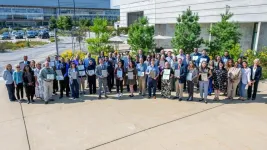(Press-News.org) A new Energy Frontier Research Center (EFRC), supported by the Department of Energy’s Office of Science and led by SLAC National Accelerator Laboratory, was awarded $14.4 million over four years to advance manufacturing of microelectronics by investigating approaches to building their components in fundamentally new ways.
Instead of moving electrons through conducting metallic interconnects in the miniscule and ever shrinking parts of devices such as microchips used in computers and cell phones, the researchers propose to move information via spin waves that can propagate through semiconductors and even insulators. A spin wave is a wave of energy that moves through a substance due to modulation of magnetic moments of atoms.
“Over the years people have tried to manipulate the electrons that produce charge in traditional microelectronics by manipulating their spin, but whenever you move around electrons you have charge current, and when you have charge current you are dissipating energy, which will cause all kinds of heating and resistance,” explained Yuri Suzuki, Stanford professor and principal investigator with the Stanford Institute of Materials and Energy Sciences (SIMES), a SLAC-Stanford joint institute.
“Our idea is to try a completely different paradigm – what if we can send information via spin waves without electrons or metals? For example, if we could replace copper interconnects with spin wave interconnects in devices, we aren’t flowing any charge current and are going to save energy.”
Suzuki will head up the EFRC called the Center for Energy Efficient Magnonics (CEEMag), working closely with SIMES Director Harold Hwang; Wei-Sheng Lee, SIMES lead scientist; and Georgi Dakovski, Matthias Hoffmann and Alexander Reid, lead scientists at SLAC’s Linac Coherent Light Source (LCLS). Other center members include researchers from seven universities – Cornell University; Morgan State University; Northwestern University; Ohio State University; University of California, Irvine; University of Iowa; and the University of Texas at Austin. The multidisciplinary team represents expertise in materials science, X-ray and ultrafast science and electrical engineering, among other areas. The collaboration is taking a co-design approach to advancing discoveries, which tackles all aspects of research and development simultaneously, from basic science to manufacturing.
Access to LCLS, the world’s most powerful X-ray laser, is key, said Suzuki, because to measure and detect spin waves requires timescales and frequencies that LCLS can probe with its ultrafast and intense pulses of X-ray light.
The team aspires to demonstrate the viability of a subset of components in microelectronics based on magnonics, or spin waves, such as interconnects, amplifiers or switches. “We are investigating fundamental science questions to see if technology based on magnonics can move the needle in terms of energy efficiency in microelectronics,” Suzuki said.
Microelectronics, which are increasingly small – tiny fractions of the smallest objects the eyes can see, are essential components in technologies of daily life: communications, transportation, health care, computing, clean energy and more.
The SLAC-led center is one of 10 EFRC’s announced Sept. 4 by the DOE to create world-class teams of scientists for groundbreaking research supporting energy technologies and to bolster the scientific workforce by attracting students to the field of energy science.
“Fundamental research in the areas covered in these awards is critical for generating foundational knowledge that underpins technologies that are important for DOE and the nation,” said Harriet Kung, acting director of the DOE Office of Science. “Strengthening our understanding of the chemistry and materials science behind advanced manufacturing of polymers, microelectronics and quantum technologies will foster a cleaner and more energy-efficient future.”
LCLS is a DOE Office of Science user facility.
END
Research Center awarded $14.4 million to advance new manufacturing solutions for microelectronics
2024-09-04
ELSE PRESS RELEASES FROM THIS DATE:
Notre Dame researchers create new tool to analyze embodied carbon in more than 1 million buildings in Chicago
2024-09-04
The built environment — which includes the construction and operation of buildings, highways, bridges and other infrastructure — is responsible for close to 40 percent of the global greenhouse gas emissions contributing to climate change.
While many building codes and benchmarks have focused on constructing “greener,” more energy-efficient new buildings, it is not enough to seek to reduce emissions in operations, said Ming Hu, the associate dean for research, scholarship and creative work in Notre Dame’s School of Architecture. Rather, policymakers and industry leaders ...
SMU researcher helps develop new technique to explore oceanic microbes
2024-09-04
DALLAS (SMU) – When SMU researcher Alexander Chase was a young boy, the sheer diversity of plants in Earth’s tropical rainforests fascinated him. He found himself wondering, what new species were out there, waiting to be unearthed? That curiosity is why Chase now collects samples from Earth’s oceans using a new technique called Small Molecule In situ Resin Capture (SMIRC), which could be the first step in uncovering compounds that lead to next-generation antibiotics.
Microbial natural products come from microorganisms, or microbes, and account for many of today’s essential medicines, including most antibiotics. Microbes are too small to see without ...
New guideline for Helicobacter pylori includes change to primary treatment recommendation
2024-09-04
The American Journal of Gastroenterology has published a new guideline on the treatment of Helicobacter pylori (H. pylori) infection.
The corresponding author on the guideline is William D. Chey, M.D., chief of the Division of Gastroenterology and Hepatology at Michigan.
H. pylori is a bacterium that infects over half the people in the world, though most are asymptomatic.
It can cause dyspepsia, peptic ulcer disease and gastric cancer.
This latest clinical practice guideline notes that its prevalence in North America is decreasing, but it still infects 30-40% of the population.
A previous guideline ...
Making desalination more efficient, by way of renewable energy
2024-09-04
(Santa Barbara, Calif.) — With freshwater becoming an ever scarcer resource, desalination of ocean water is increasingly employed to bridge the gap between supply and demand. However, desalination is energy-intensive, often powered by fossil fuels, so meeting the need for freshwater can exacerbate the challenge of reducing atmospheric CO2, the main driver of climate change.
Yangying Zhu, an assistant professor in the Department of Mechanical Engineering at UC Santa Barbara, wants to address that conundrum. Now, a two-year, $500,000 seed grant from the Advanced Research Projects Agency-Energy (ARPA-E) ...
Preventing car battery fires with help from machine learning
2024-09-04
One of the most critical safety concerns for electric vehicles is keeping their batteries cool, as temperature spikes can lead to dangerous consequences.
New research led by a University of Arizona doctoral student proposes a way to predict and prevent temperature spikes in the lithium-ion batteries commonly used to power such vehicles.
The paper "Advancing Battery Safety," led by College of Engineering doctoral student Basab Goswami, is published in the Journal of Power Sources.
With the support of $599,808 from the Department of Defense's Defense Established Program to Stimulate Competitive Research, Goswami and his adviser, aerospace ...
Heavy metal cadmium may be tied to memory issues for some
2024-09-04
MINNEAPOLIS – The heavy metal cadmium, which is found in the air, water, food and soil, is known to cause health problems. A new study published in the September 4, 2024, online issue of Neurology®, the medical journal of the American Academy of Neurology, examined if thinking and memory skills were associated with cadmium exposure. They found no association when they looked at the group as a whole. However, when looking at Black and white people separately, it found cadmium may be tied to problems with thinking and memory skills in white people. ...
Strictest abortion-ban states offer least family support
2024-09-04
View a breakdown of the abortion restrictions by state below
States with early abortion bans are less likely to offer paid time off after childbearing, to give poor children nutritional support or to expand access to reproductive health care
Marginalized people and those with low socioeconomic status are overrepresented in ban states and least likely to overcome the barriers that bans impose
CHICAGO --- States with the most severe post-Dobbs abortion restrictions also have the fewest policies in place to support raising families, reports a new Northwestern Medicine study.
“We found that in the states that most severely ...
Study: People facing life-or-death choice put too much trust in AI
2024-09-04
In simulated life-or-death decisions, about two-thirds of people in a UC Merced study allowed a robot to change their minds when it disagreed with them -- an alarming display of excessive trust in artificial intelligence, researchers said.
Human subjects allowed robots to sway their judgment despite being told the AI machines had limited capabilities and were giving advice that could be wrong. In reality, the advice was random.
“As a society, with AI accelerating so quickly, we need to be concerned about the potential for overtrust,” said Professor Colin ...
Leaders of ‘EV Ready’ Illinois cities recognized in ceremony at Argonne
2024-09-04
City leaders who are working to accommodate more electric vehicles (EVs) were recognized in a ceremony o Aug. 23 at the U.S. Department of Energy’s (DOE) Argonne National Laboratory. Utility ComEd and the Metropolitan Mayors Caucus spotlighted 12 communities in northern Illinois that recently completed the EV Readiness Program.
The EV Readiness Program trains and assists local government officials in taking concrete steps to support EV adoption. As a national leader in EV research, ...
Survey shows nearly 70% of US hospitals affiliated with medical schools host a fast-food restaurant; Chick-fil-A, McDonald’s among most common
2024-09-04
WASHINGTON, D.C.—A new survey by the Physicians Committee for Responsible Medicine published in the American Journal of Lifestyle Medicine reveals that 69.2% of U.S. hospitals affiliated with a medical school host at least one fast-food restaurant. The five most common fast-food restaurants located in hospitals were Starbucks, Subway, Chick-fil-A, Au Bon Pain, and McDonald’s.
“Making fast food like cheeseburgers and fried chicken available in hospitals is hazardous to the health of patients, visitors, and staff,” says Zeeshan Ali, PhD, the lead author of the paper and a nutrition program specialist with the Physicians Committee. “Hospitals ...







